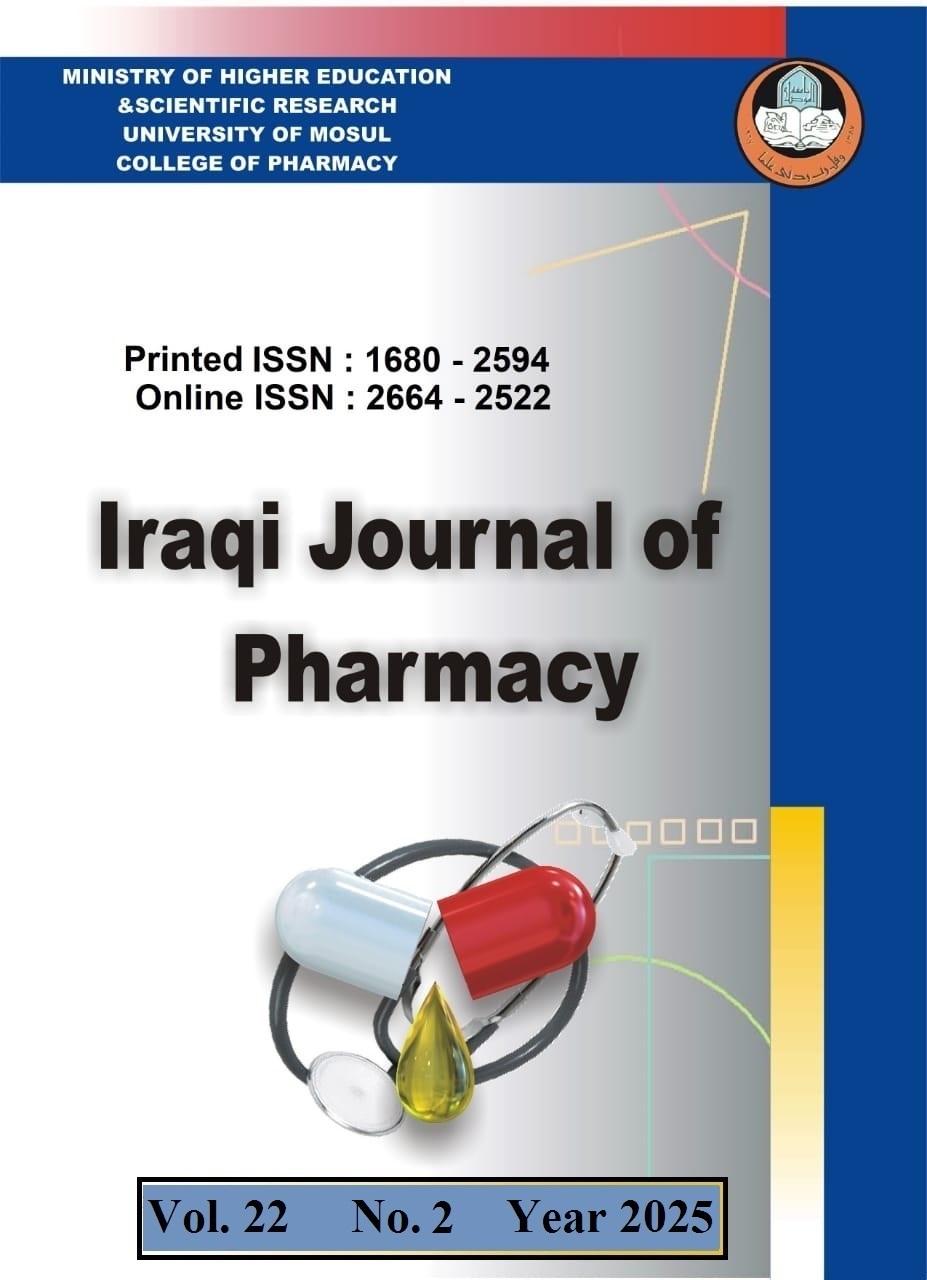Characterization and Quantification of Active Components of Yerba Mate Extract
Abstract
Background and objectives: Yerba Mate is commonly used as a popular tea due to its delicious taste and bright colour after preparation. It contains active ingredients that might have therapeutic benefits. This study aimed to identify and quantify active ingredients present in Yerba Mate extract (YME). Methods: To do so, YME was prepared by wet digestion and the extract was dried at room temperature. Vitamin E and C were determined using the UV-visible spectrophotometer, minerals were determined by atomic absorption and organic polyphenols were determined using "high-performance liquid chromatography". Results: The contents disclosed the presence of vitamin E (9.8 mg/gm), vitamin C (12.5 mg/gm), phosphate (145.9 g/gm), iron (80.9 g/gm), calcium (80.6 g/gm), magnesium (66.3 g/gm), and zinc (41.9 g/gm). Additionally, gallic acid (98.8g/gm), ferulic acid (60.5g/gm), caffeic acid (55.9 g/gm), apigenin (30.5 g/gm), chlorogenic acid (24.8 g/gm), and kaempferol (12.9 g/gm). Conclusion: the concentration and active ingredient present in YME enable its use in some diseases including diabetes mellitus, hyperlipidemia, and bone diseases due to their antioxidant, lipid-lowering and bone-strengthening effects.
References
- Andersen T, Fogh J. Weight loss and delayed gastric emptying following a South American herbal preparation in overweight patients. Journal of Human Nutrition and Dietetics. 2001;14(3):243-250.
- Bains Y, Gugliucci A. Ilex paraguariensis and its main component chlorogenic acid inhibit fructose formation of advanced glycation endproducts with amino acids at conditions compatible with those in the digestive system. Fitoterapia. 2017;117:6-10.
- Baird R, Rice E, Eaton A. Standard methods for the examination of water and wastewaters. Water Environment Federation, Chair Eugene W. Rice, American Public Health Association Andrew D. Eaton, American Water Works Association. 2017;1:71-90.
- Bastos MC, Reissmann CB, Keseker JF, Pauletti V, Gaiad S, Sturion JA. Mineral content of young leaves of yerba mate. http://www.alice.cnptia.embrapa.br/alice/handle/doc/990949
- Becker AM, Cunha HP, Lindenberg AC, de Andrade F, de Carvalho T, Boaventura BC, et al. Spray-dried yerba mate extract capsules: clinical evaluation and antioxidant potential in healthy individuals. Plant Foods for Human Nutrition. 2019;74:495-500.
- Bracesco N, Sanchez AG, Contreras V, Menini T, Gugliucci A. Recent advances on Ilex paraguariensis research: Minireview. Journal of ethnopharmacology. 2011;136(3):378-84.
- Brun LR, Brance ML, Lombarte M, Maher MC, Di Loreto VE, Rigalli A. Effects of yerba mate (IIex paraguariensis) on histomorphometry, biomechanics, and densitometry on bones in the rat. Calcified tissue international. 2015;97(5):527-534.
- Burris KP, Harte FM, Davidson PM, Stewart Jr CN, Zivanovic S. Composition and bioactive properties of yerba mate (Ilex paraguariensis A. St.-Hil.): a review. Chilean journal of agricultural research. 2012;72(2):268-274.
- Ceballos RL, Ochoa-Yepes O, Goyanes S, Bernal C, Fam L. Effect of yerba mate extract on the performance of starch films obtained by extrusion and compression molding as active and smart packaging. Carbohydrate polymers. 2020;244:116495: 1-10.
- Chen AY, Chen YC. A review of the dietary flavonoid, kaempferol on human health and cancer chemoprevention. Food chemistry. 2013;138(4):2099-107.
- Dabulici CM, Srbu I, Vamanu E. The bioactive potential of functional products and bioavailability of phenolic compounds. Foods. 2020;9(7):953:1-15.
- De Morais EC, Stefanuto A, Klein GA, Boaventura BC, De Andrade F, Wazlawik E, et al. Consumption of yerba mate (Ilex paraguariensis) improves serum lipid parameters in healthy dyslipidemic subjects and provides an additional LDL-cholesterol reduction in individuals on statin therapy. Journal of Agricultural and Food Chemistry. 2009;57(18):8316-24.
- Desai AP, Desai S. UV spectroscopic method for determination of vitamin C (ascorbic acid) content in different fruits in south Gujarat Region. International Journal of Environmental Sciences and Natural Resources. 2019;21(2):41-4.
- Elgailani IE, Elkareem MA, Noh E, Adam O, Alghamdi A. Comparison of two methods for the determination of vitamin C (ascorbic acid) in some fruits. American Journal of Chemistry. 2017;2(1):1-7.
- GarciaLazaro RS, Lamdan H, Caligiuri LG, Lorenzo N, Berengeno AL, Ortega HH, et al. In vitro and in vivo antitumor activity of Yerba Mate extract in colon cancer models. Journal of Food Science. 2020;85(7):2186-97.
- Grando RL, Schumacher SO, Carvajal E, Fierro IM. Yerba mate: Uses and applications evaluated through patent documents. The Natural Products Journal. 2017;7(4):309-15.
- Hu X, Wang L, He Y, Wei M, Yan H, Zhu H. Chlorogenic acid promotes osteogenic differentiation of human dental pulp stem cells through Wnt signaling. Stem Cells and Development. 2021;30(12):641-50.
- Junior EL, Morand C. The interest of mate (Ilex paraguariensis A. St.-Hil.) as a new natural functional food to preserve human cardiovascular healthA review. Journal of functional foods. 2016;21:440-54.
- Konieczynski P, Viapiana A, Wesolowski M. Comparison of infusions from black and green teas (Camellia sinensis L. Kuntze) and Erva-mate (Ilex paraguariensis A. St.-Hil.) based on the content of essential elements, secondary metabolites, and antioxidant activity. Food Analytical Methods. 2017;10:3063-70.
- Kwak SC, Lee C, Kim JY, Oh HM, So HS, Lee MS, et al. Chlorogenic acid inhibits osteoclast differentiation and bone resorption by down-regulation of receptor activator of nuclear factor kappa-B ligand-induced nuclear factor of activated T cells c1 expression. Biological and Pharmaceutical Bulletin. 2013;36(11):1779-86.
- Lacerda SA, Matuoka RI, Macedo RM, Petenusci SO, Campos AA, Brentegani LG. Bone quality associated with daily intake of coffee: a biochemical, radiographic and histometric study. Brazilian dental journal. 2010;21:199-204.
- Leonard W, Zhang P, Ying D, Fang Z. Hydroxycinnamic acids on gut microbiota and health. Comprehensive reviews in food science and food safety. 2021;20(1):710-37.
- Liu H, Yao K, Zhang W, Zhou J, Wu T, He C. Coffee consumption and risk of fractures: a meta-analysis. Archives of Medical Science. 2012 Nov 7;8(5):776-83.
- Lorini A, Damin FM, de Oliveira DN, Crizel RL, Godoy HT, Galli V, et al. Characterization and quantification of bioactive compounds from Ilex paraguariensis residue by HPLCESIQTOFMS from plants cultivated under different cultivation systems. Journal of Food Science. 2021;86(5):1599-619.
- Lutomski P, Gozdziewska M, Florek-Luszczki M. Health properties of yerba mate. Annals of Agricultural and Environmental Medicine. 2020;27(2):310-313.
- Mas AL, Brigante FI, Salvucci E, Ribotta P, Martinez ML, Wunderlin DA, et al. Novel cookie formulation with defatted sesame flour: Evaluation of its technological and sensory properties. Changes in phenolic profile, antioxidant activity, and gut microbiota after simulated gastrointestinal digestion. Food Chemistry. 2022;389:133122:1-10.
- Mateos R, Baeza G, Sarri B, Bravo L. Improved LC-MSn characterization of hydroxycinnamic acid derivatives and flavonols in different commercial mate (Ilex paraguariensis) brands. Quantification of polyphenols, methylxanthines, and antioxidant activity. Food Chemistry. 2018;241:232-41.
- Moreno MC, Cavalcante GR, Lins RD, Pereira HS. Caffeine effect on bone metabolism in rats: a systematic review. Brazilian Archives of Biology and Technology. 2021;64:e21200802:1-11.
- Paluch E, Okiczyc P, Zwyrzykowska-Wodziska A, Szperlik J, arowska B, Duda-Madej A, et al. Composition and antimicrobial activity of Ilex leaves water extracts. Molecules. 2021;26(24):7442:1-35.
- Piovezan-Borges AC, Valrio-Jnior C, Gonalves IL, Mielniczki-Pereira AA, Valduga AT. Antioxidant potential of yerba mate (Ilex paraguariensis St. Hil.) extracts in Saccharomyces cerevisae deficient in oxidant defense genes. Brazilian journal of biology. 2016;76(2):539-44.
- Salehi B, Venditti A, Sharifi-Rad M, Krgiel D, Sharifi-Rad J, Durazzo A, et al. The therapeutic potential of apigenin. International journal of molecular sciences. 2019;20(6):1305:1-26.
- Samydurai P, Ramakrishnan R, Nagarajan N. Polyphenols, vitamin-E estimation and in vitro antioxidant activity of Adiantum capillus-veneris. International Journal of Innovative Pharmaceutical Sciences and Research. 2013;4:258-62.
- Valenca SS, Lanzetti M, Porto LC. Mate Tea. In: Tea in Health and Disease Prevention [Internet]. Elsevier; 2013 . p. 16170. Available from: https://linkinghub.elsevier.com/retrieve/pii/B9780123849373000136
- Zhou RP, Lin SJ, Wan WB, Zuo HL, Yao FF, Ruan HB, et al. Chlorogenic acid prevents osteoporosis by Shp2/PI3K/Akt pathway in ovariectomized rats. PLoS One. 2016;11(12):e0166751:1-19.
- Ziemlewska A, Nizio-ukaszewska Z, Bujak T, Zagrska-Dziok M, Wjciak M, Sowa I. Effect of fermentation time on the content of bioactive compounds with cosmetic and dermatological properties in Kombucha Yerba Mate extracts. Scientific Reports. 2021;11(1):18792:1-15.








